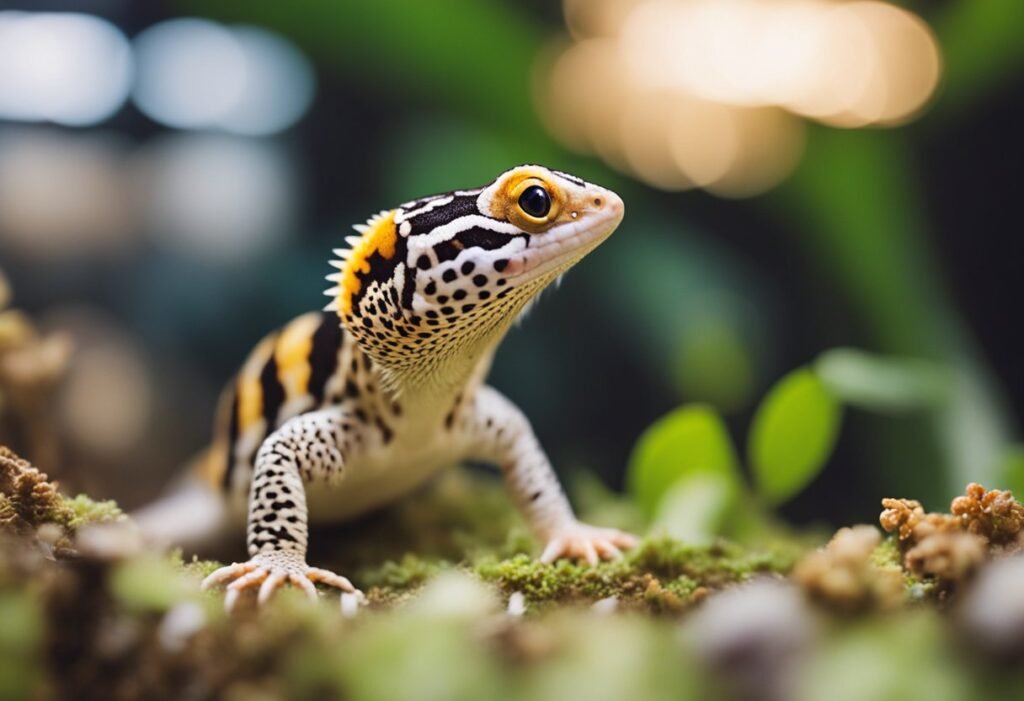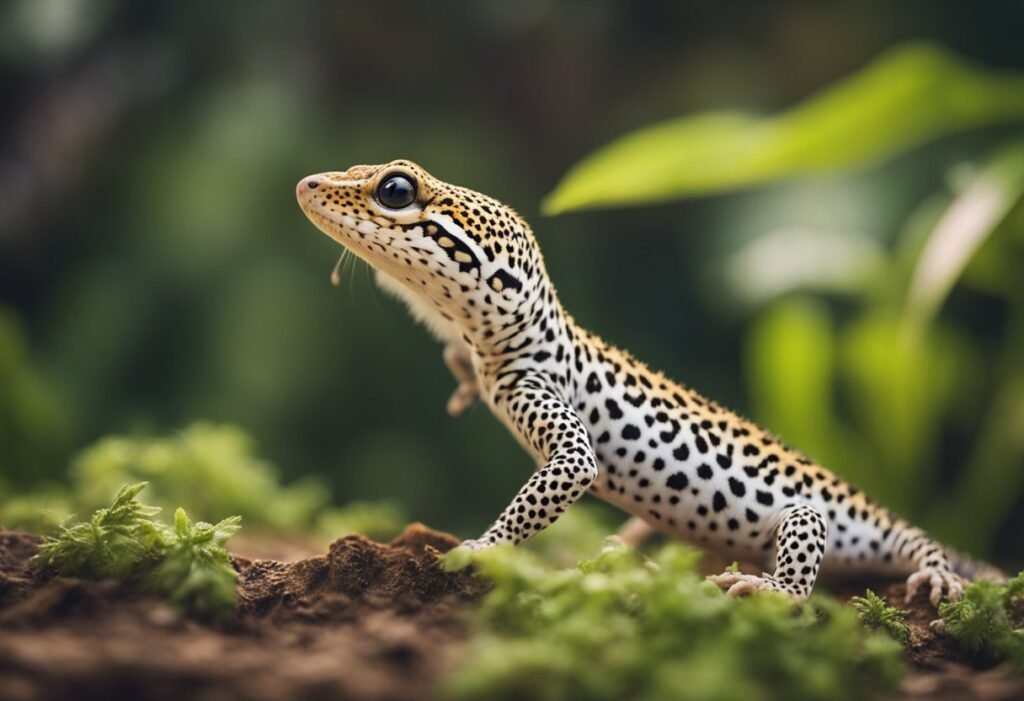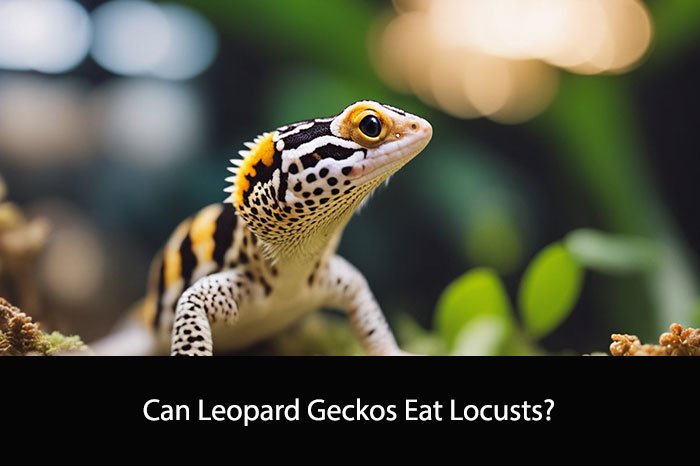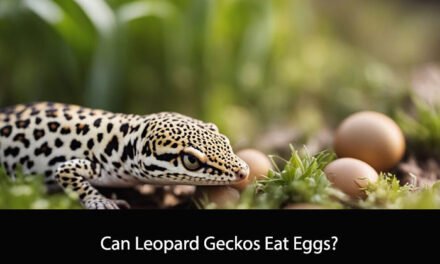Leopard geckos are popular pets among reptile enthusiasts due to their docile nature and unique patterns. As with any pet, it is important to ensure that they are receiving a proper diet. One question that often arises is whether leopard geckos can eat locusts.
The answer is yes, leopard geckos can eat locusts. In fact, they are a great source of protein and other nutrients for these reptiles. However, it is important to ensure that the locusts are properly gut-loaded and dusted with calcium and other supplements before feeding them to your leopard gecko.
In this article, we will explore the benefits of feeding locusts to leopard geckos, how to properly prepare them for feeding, and any potential risks associated with this type of diet. By the end of this article, you will have a better understanding of whether locusts are a suitable addition to your leopard gecko’s diet.
Dietary Needs of Leopard Geckos

As responsible pet owners, we must ensure that we provide our leopard geckos with a balanced and nutritious diet. Leopard geckos are insectivores, which means they primarily eat insects. A varied diet is essential to meet their nutritional needs, and it is crucial to offer them a variety of insects.
Leopard geckos require a high-protein diet, and insects such as crickets, mealworms, and dubia roaches are excellent sources of protein. It is essential to gut-load insects before feeding them to our leopard geckos. Gut-loading involves feeding the insects with nutrient-rich foods to enhance their nutritional value.
In addition to protein, leopard geckos require calcium and other essential vitamins and minerals to maintain good health. It is essential to dust the insects with a calcium supplement before feeding them to our leopard geckos. Leopard geckos also require access to fresh water at all times.
Locusts are another excellent source of protein for leopard geckos. However, it is essential to ensure that the locusts are the appropriate size for our leopard geckos. Offering too large locusts can result in choking or other digestive problems. It is also crucial to avoid feeding wild-caught locusts as they may have been exposed to pesticides or other harmful substances.
In conclusion, a varied diet that includes a variety of insects, gut-loaded with nutrient-rich foods, dusted with calcium supplements, and fresh water is essential to meet the dietary needs of our leopard geckos. Locusts can be an excellent addition to their diet, but it is crucial to ensure that they are the appropriate size and not wild-caught.
Benefits of Locusts in a Leopard Gecko’s Diet
When it comes to feeding leopard geckos, locusts are a great addition to their diet. Here are some of the benefits of feeding locusts to your leopard gecko.
Nutritional Value
Locusts are a great source of nutrition for leopard geckos. They are high in protein, which is essential for growth and maintenance of muscle tissue. They also contain important vitamins and minerals, such as calcium, which is important for bone health.
Digestibility
Leopard geckos have a sensitive digestive system, and it’s important to feed them food that is easy to digest. Locusts are a great choice because they are low in fat and easy to digest. This means that your leopard gecko can easily absorb the nutrients from the locusts without putting too much strain on their digestive system.
Variety and Enrichment
Feeding your leopard gecko a varied diet is important for their overall health and well-being. Adding locusts to their diet provides variety and can help prevent boredom. In addition, hunting and catching live prey can provide enrichment for your leopard gecko, which can help keep them mentally and physically stimulated.
In summary, feeding locusts to your leopard gecko can provide a range of benefits, including nutrition, digestibility, and enrichment. However, it’s important to remember to feed locusts in moderation and to always provide fresh water and appropriate supplementation.
Feeding Locusts to Leopard Geckos

Leopard geckos are carnivorous reptiles that require a diet rich in protein to stay healthy. Feeding them a variety of insects is essential to ensure they get all the nutrients they need. One such insect that can be fed to leopard geckos is the locust. In this section, we will discuss how to source, prepare, and safely feed locusts to leopard geckos.
Sourcing Locusts
Locusts can be purchased from pet stores or online retailers that specialize in reptile food. It is important to ensure that the locusts are healthy and free from any parasites or diseases. We recommend purchasing live locusts as they are more nutritious than frozen or pre-killed ones.
Preparing Locusts for Feeding
Before feeding the locusts to your leopard gecko, it is important to prepare them properly. This involves gut-loading the locusts with nutritious food and dusting them with calcium and vitamin supplements.
Gut-loading involves feeding the locusts with a nutritious diet for at least 24 hours before feeding them to your leopard gecko. This ensures that the locusts are packed with nutrients that your gecko needs.
Dusting the locusts with calcium and vitamin supplements is also important as it ensures that your gecko gets all the essential nutrients it needs to stay healthy. We recommend dusting the locusts with supplements at least once a week.
Safe Feeding Practices
When feeding locusts to your leopard gecko, it is important to follow safe feeding practices. This involves ensuring that the locusts are an appropriate size for your gecko and that they are fed in a clean environment.
We recommend feeding locusts that are no larger than the width of your gecko’s head. This ensures that they can be safely swallowed without causing any harm to your gecko.
It is also important to feed your gecko in a clean environment to prevent the risk of bacterial infections. We recommend using a separate feeding dish that is cleaned after each feeding.
In conclusion, feeding locusts to your leopard gecko can be a nutritious and enjoyable part of their diet. By following the steps outlined in this section, you can ensure that your gecko gets all the essential nutrients it needs to stay healthy.
Risks and Considerations
When considering feeding your leopard gecko locusts, there are a few risks and considerations to keep in mind. Here are some important factors to consider:
Potential Health Risks
While locusts are generally considered safe for leopard geckos to eat, there is always a risk of illness or injury. Some locusts may carry parasites or diseases that could be harmful to your pet. It’s important to purchase locusts from a reputable source and inspect them carefully before feeding them to your gecko.
Additionally, feeding your gecko too many locusts at once can lead to digestive issues, such as impaction. This occurs when undigested food builds up in the digestive tract, causing blockages and other health problems. To avoid this, it’s important to feed your gecko an appropriate amount of locusts based on their size and age.
Allergies and Sensitivities
Just like humans, leopard geckos can have allergies or sensitivities to certain foods. If you notice any signs of allergic reactions, such as swelling or difficulty breathing, stop feeding your gecko locusts immediately and consult with a veterinarian.
Frequency and Quantity
While locusts can be a nutritious addition to your gecko’s diet, it’s important to feed them in moderation. Overfeeding can lead to obesity and other health issues. As a general rule, adult leopard geckos should be fed 2-3 times per week, while juveniles may require more frequent feedings.
When feeding your gecko locusts, it’s important to offer them an appropriate amount based on their size and age. As a general guideline, offer 2-3 appropriately sized locusts per feeding for adult geckos, and adjust the quantity based on your gecko’s individual needs.
By keeping these risks and considerations in mind, you can safely incorporate locusts into your leopard gecko’s diet and provide them with a varied and nutritious meal plan.
Alternatives to Locusts

Other Insect Options
While leopard geckos can eat locusts, there are other insect options that can be included in their diet for variety and nutrition. Some of these options include:
- Crickets: Crickets are a popular choice for leopard geckos and are readily available at most pet stores. They are a good source of protein and can be dusted with calcium and vitamin supplements before being fed to your gecko.
- Dubia Roaches: Dubia roaches are another popular option for leopard geckos and are also available at most pet stores. They are high in protein and low in fat, making them a nutritious addition to your gecko’s diet.
- Mealworms: Mealworms are a good source of protein and can be fed to leopard geckos as an occasional treat. However, they should not be the main staple of their diet as they are high in fat and low in calcium.
Supplementing the Diet
In addition to offering a variety of insects, it is important to supplement your leopard gecko’s diet with calcium and vitamin supplements. These supplements can be dusted onto the insects before feeding them to your gecko.
Calcium is essential for strong bones and can help prevent metabolic bone disease, which is a common health issue in leopard geckos. Vitamin supplements can help ensure that your gecko is getting all the necessary vitamins and minerals in their diet.
It is important to follow the recommended dosage instructions when using supplements and to avoid over-supplementing, as this can also lead to health issues.
Frequently Asked Questions
Are locusts a safe food option for leopard geckos?
Yes, locusts are a safe food option for leopard geckos when appropriately prepared and fed in moderation. They are a great source of protein and other essential nutrients that are necessary for your gecko’s health.
What are the potential risks of feeding locusts to leopard geckos?
Feeding your leopard gecko too many locusts or not preparing them correctly can result in potential health risks. For example, feeding your gecko too many large locusts can cause impaction, which can result in serious digestive issues. Additionally, if the locusts are not gut-loaded or dusted with supplements, they may not provide the necessary nutrients your gecko needs.
How should locusts be prepared before offering them to a leopard gecko?
Before offering locusts to your leopard gecko, you should ensure that they are gut-loaded with nutritious food and dusted with a calcium and vitamin supplement. You can also offer them live or pre-killed, depending on your gecko’s preference.
What is the nutritional value of locusts for leopard geckos?
Locusts are an excellent source of protein, calcium, and other essential nutrients that are necessary for your leopard gecko’s health. They also have a low-fat content, making them a great food option for geckos that are prone to obesity.
How often can leopard geckos be fed locusts in their diet?
Leopard geckos can be fed locusts as part of a balanced diet, but they should not make up the entirety of their diet. We recommend feeding your gecko a variety of insects, including locusts, and alternating their diet to ensure they receive a balanced range of nutrients.
Are there any size considerations when feeding locusts to leopard geckos?
Yes, it is essential to consider the size of the locusts you are feeding your gecko. Larger locusts can cause impaction, so it is best to feed your gecko smaller locusts that are appropriate for their size. As a general rule, the size of the locust should be no larger than the space between your gecko’s eyes.





